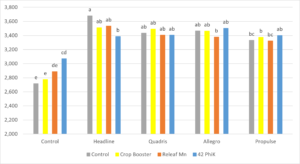Growers often apply fungicides to manage foliar diseases such as anthracnose, and tankmix a foliar fertilizer when they apply a fungicide to reduce application costs. It is unknown if the tankmix reduces anthracnose control from the fungicide. The purpose of this study was to measure fungicide performance under moderate to severe anthracnose pressure, with and without the addition of three popular foliar fertilizers commonly used in dry beans, across multiple environments in Ontario.
Four small plot studies tested anthracnose fungicides (Headline, Quadris, Allegro and Propulse) tankmixed with foliar fertilizers (Crop Booster, Releaf Mn and 42PhiK) at Exeter ON in 2018 and 2021. Measurements included disease incidence and severity, as well as crop yield.

The application of a fungicide increased crop yield, compared to the untreated control (Figure 1). Disease severity results found the strobilurin fungicides (Headline, Quadris) were best, followed by Allegro and then Propulse (data not shown). The fertilizers tested do not reduce fungicide performance in a tankmix, compared to the fungicide applied alone (Figure 1). The fertilizer 42PhiK increased yield in the control, compared to the untreated plot. The product 42PhiK also reduced anthracnose disease severity when it was applied alone or tankmixed with a moderately effective fungicide like Propulse (data not shown), but 42PhiK had no effect when it was combined with highly effective fungicide products. Please check with your bean marketing company first before applying 42PhiK or any product to your crop, to ensure it meets with the approval of bean end users.